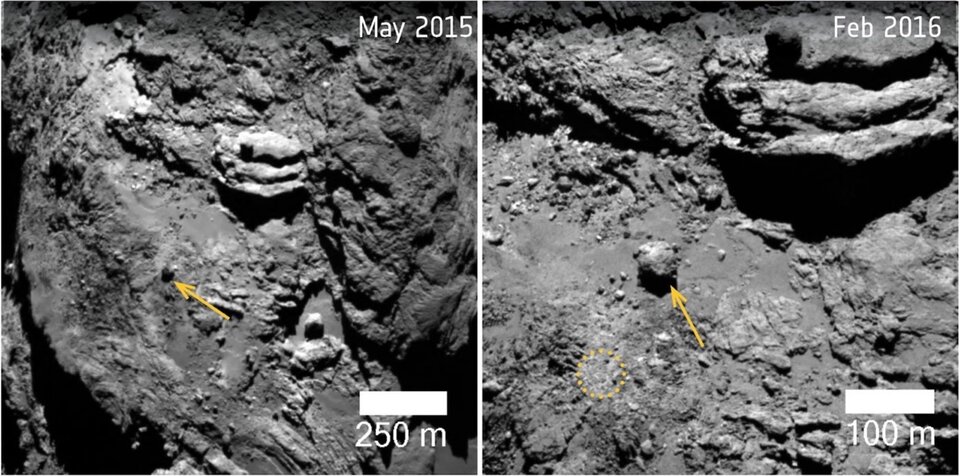

Good at ‘spot the differences’? Then ESA is looking for you!
It is 2014 when the Rosetta spacecraft arrives at Comet 67P/Churyumov-Gerasimenko. For two years, the spacecraft studied the comet closely and witnessed many landscape changes: from collapsed cliffs and the formation of pits to evolving dust patterns and rolling boulders. Now scientists are seeking help. Because the probe has collected so much data that ESA can use all the extra eyes to unravel the secrets of Rosetta’s comet.
Surface changes
About halfway through Rosetta’s mission, Comet 67P/Churyumov-Gerasimenko was closest to the sun; a moment known as the perihelion. The comet then moved away from our parent star, illuminating the surface of Rosetta’s comet in various ways. It means the spacecraft was able to collect a ton of data, including intriguing surface changes. And scientists are very interested in that. These could help investigate the mechanism by which a comet sheds its outer layers when sunlight heats the ice and dust around its core.
Complex task
But scientists have now run into a ‘luxury problem’. Rosetta has collected so much data that mapping all surface changes has become a very complex task. “The Rosetta Archive contains a huge amount of data collected during the extraordinary mission that has only been partially explored,” said study researcher Bruno Merín.
ESA is looking for you!
And so ESA is looking for help. Yours. The space agency invites volunteers to participate in a comic game of ‘spot the differences’. Anyone who wishes can browse through photos collected during ESA’s Rosetta mission to help scientists reveal how a comet’s surface evolves as it orbits the sun. “In recent years, astrophotographers and space enthusiasts have noticed changes and signs of activity in Rosetta’s images,” explains Merín. “However, with the exception of a few cases, it was not possible to link these events to surface changes, mainly due to the lack of human eyes that search the entire dataset. We definitely need more eyes!”
That is how it works
How it works? Each time you will see a pair of images collected by Rosetta’s OSIRIS camera showing the surface of Comet 67P before and after perihelion. It means that you are viewing images from approximately the same region side by side. Then it’s up to you to identify the differences and changes; from large-scale dust transport to comet chunks that have moved or even disappeared.

Displacement of a 30m wide boulder over a distance of approximately 140m. Image: Van El-Maarry et al. (2017)
Sometimes it may be necessary to zoom in or out a few times, or rotate the images to see changes at different scales and get a closer look at the iconic comet.
Cards
Ultimately, the scientists hope to produce detailed maps of the changes and active regions on the comet’s surface. Scientists will then be able to link the comet’s activity to changes on its surface. And in that way they want to unravel many more secrets of Rosetta’s comet, as well as many others. “What does a primitive comet look like? Nobody knows,” said researcher Jean-Baptiste Vincent. “But with the help of volunteers, we can characterize how comets evolve and understand the physics driving these changes: then we will be able to rewind the movie of comet evolution all the way back to the origin of the solar system.”
Everyone can participate for free (click here† you don’t need to sign up, install an app or program, or have any scientific experience whatsoever. Simply spot the differences between image pairs whenever you have the time – whether that’s five minutes while you wait for the bus, or evenings. You decide. Good luck!
Source material:
†‘Spot the difference’ to help reveal Rosetta image secrets” – ESA
Image at the top of this article: ESA/ATG media lab; Comet image: ESA/Rosetta/Navcam